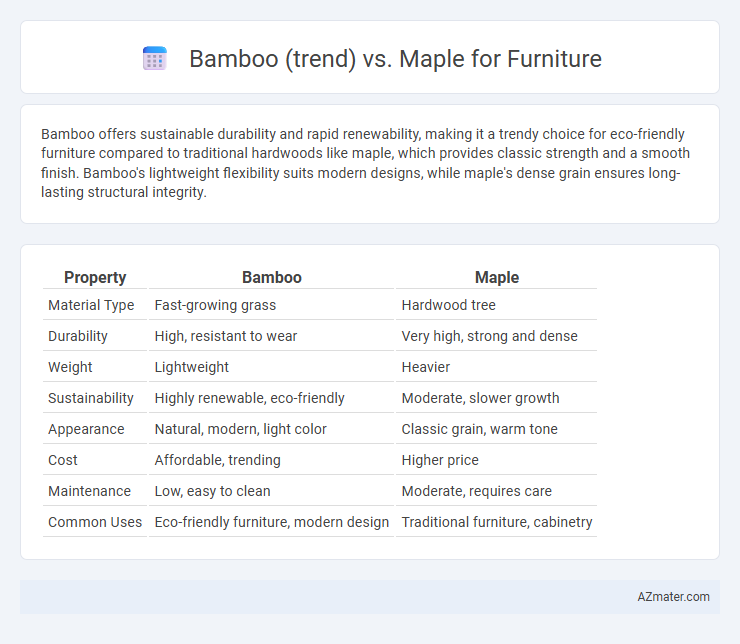Bamboo offers sustainable durability and rapid renewability, making it a trendy choice for eco-friendly furniture compared to traditional hardwoods like maple, which provides classic strength and a smooth finish. Bamboo's lightweight flexibility suits modern designs, while maple's dense grain ensures long-lasting structural integrity.
Table of Comparison
| Property | Bamboo | Maple |
|---|---|---|
| Material Type | Fast-growing grass | Hardwood tree |
| Durability | High, resistant to wear | Very high, strong and dense |
| Weight | Lightweight | Heavier |
| Sustainability | Highly renewable, eco-friendly | Moderate, slower growth |
| Appearance | Natural, modern, light color | Classic grain, warm tone |
| Cost | Affordable, trending | Higher price |
| Maintenance | Low, easy to clean | Moderate, requires care |
| Common Uses | Eco-friendly furniture, modern design | Traditional furniture, cabinetry |
Understanding the Bamboo Trend in Furniture
Bamboo furniture has surged in popularity due to its sustainability, rapid growth rate, and strength comparable to hardwoods, making it an eco-friendly alternative to traditional materials like maple. Its natural resistance to moisture and insects, combined with a light, flexible texture, appeals to modern consumers seeking durable yet stylish home furnishings. While maple remains prized for its hardness and warm grain, the bamboo trend reflects an increasing demand for renewable resources and innovative design in the furniture industry.
Maple Wood: Classic Choice for Timeless Furniture
Maple wood remains a classic choice for timeless furniture due to its durability, fine grain, and smooth finish that enhances intricate craftsmanship. While bamboo offers rapid renewability and a modern aesthetic, maple's traditional appeal and resistance to wear make it ideal for heirloom-quality pieces. Its natural hardness and uniform texture ensure longevity, sustaining elegant designs across generations.
Sustainability: Bamboo vs Maple Wood
Bamboo is a highly sustainable choice for furniture due to its rapid growth rate, regenerating fully within 3-5 years without requiring replanting, making it an eco-friendly alternative to traditional hardwoods like maple, which takes 40-60 years to mature. Bamboo's carbon sequestration capabilities surpass many trees, reducing environmental impact and promoting a greener supply chain. Maple wood, while durable and strong, has a longer harvesting cycle and leads to higher deforestation rates, making bamboo preferable for environmentally conscious furniture production.
Durability and Strength Comparison
Bamboo furniture outperforms maple in durability due to its rapid growth cycle, resulting in dense, strong fibers that resist dents and scratches better than hardwood. Maple, while also strong, is heavier and more prone to surface wear under heavy use, especially in softer grain areas. Bamboo's tensile strength rivals steel, making it an eco-friendly yet resilient choice for long-lasting furniture compared to traditional maple.
Aesthetic Appeal: Bamboo versus Maple Designs
Bamboo furniture offers a contemporary, eco-friendly aesthetic with its smooth, linear grain and light golden hue, appealing to modern minimalist and sustainable design trends. Maple furniture boasts a classic, warm appearance characterized by its fine, even grain and creamy to reddish-brown color, providing timeless elegance and versatility in various interior styles. The choice between bamboo and maple designs depends on whether a space seeks a sleek, green-conscious vibe or a traditional, rich wood aesthetic.
Cost Analysis: Investing in Bamboo or Maple
Bamboo furniture typically offers a cost-effective option due to its rapid growth cycle and abundance, making it more affordable than maple, which requires decades to mature. Maple furniture, while generally higher in upfront cost, provides durability and a classic hardwood aesthetic that can increase long-term value and resale potential. The investment decision hinges on budget constraints and desired longevity, with bamboo excelling in sustainability and lower price points, and maple favored for premium quality and lasting appeal.
Maintenance and Care Differences
Bamboo furniture offers exceptional resistance to moisture and scratches, requiring minimal maintenance with occasional dusting and a damp cloth for cleaning, making it ideal for high-traffic areas. Maple furniture, though durable, demands more careful upkeep with regular polishing and protection from excessive moisture to prevent warping and surface damage. The denser grain of maple necessitates periodic oiling or waxing to maintain its finish, whereas bamboo's natural hardness reduces the need for extensive care products.
Environmental Impact and Carbon Footprint
Bamboo furniture significantly reduces environmental impact due to its rapid growth rate and high carbon sequestration capacity, absorbing up to 12 tons of CO2 per hectare annually. Maple, while durable and widely used, grows much slower and requires longer harvesting cycles, resulting in a higher carbon footprint per piece of furniture. Bamboo's renewability and lower energy consumption during processing make it a superior sustainable choice compared to traditional hardwoods like maple.
Popular Furniture Types: Bamboo vs Maple
Bamboo furniture, valued for its sustainability and rapid growth, is popular in contemporary dining tables, chairs, and outdoor patio sets thanks to its lightweight and moisture-resistant properties. Maple furniture, renowned for its durability and fine grain, is frequently used in hardwood flooring, cabinetry, and classic bedroom sets, offering a smooth finish and traditional aesthetic. Both materials serve distinct design needs, with bamboo favored for eco-friendly, modern styles and maple favored for sturdiness and timeless elegance.
Which is Right for You: Bamboo Trend or Maple Tradition?
Bamboo furniture offers exceptional sustainability with its rapid growth cycle and natural resistance to moisture, making it ideal for eco-conscious consumers seeking modern, lightweight designs. Maple, renowned for its durability and classic grain patterns, provides long-lasting strength and timeless appeal, favored in traditional and high-traffic environments. Choosing between bamboo and maple depends on your preference for environmentally friendly innovation versus established hardwood reliability in furniture.

Infographic: Bamboo (trend) vs Maple for Furniture
 azmater.com
azmater.com